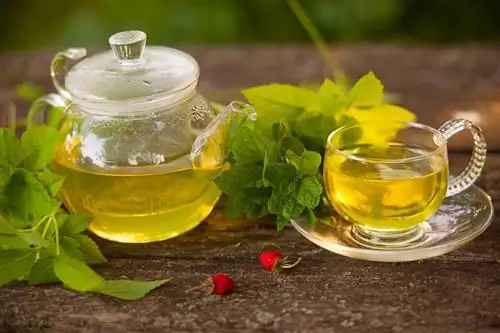- Author admin [email protected].
- Public 2023-12-16 16:46.
- Last modified 2025-01-23 11:22.
Houseleek has a long tradition as a medicinal plant. To this day, naturopaths revere the common houseleek (Sempervivum tectorum) as a remedy for a variety of ailments. Find out here what healing powers houseleek has. Read ready-to-use recipes for soothing preparations here.

What is houseleek used for as a medicinal plant?
Houseleek (Sempervivum tectorum) is a medicinal plant with anti-inflammatory, wound-healing and pain-relieving properties. Common uses include skin problems, corns, ear and eye infections, stomach problems and weak libido. Healing ointment and tincture can be made yourself.
How can I use houseleek as a medicinal plant?
Since the early Middle Ages, legendary herbalists such as Hildegard von Bingen and Pastor Kneipp have reported on houseleek as a medicinal plant. To this day, naturopaths attest primarily to the true houseleek (Sempervivum tectorum) for theseexternal and internal uses:
- Skin conditions, such as wounds, warts, sunburns, burns or insect bites
- corns, hemorrhoids
- Eye and ear infections, deafness
- Nausea, vomiting, stomach ulcers
- Declining libido
How does houseleek work as a medicinal plant?
The houseleek contains aconcentrated load of effective ingredients in its succulent plant partsThese include tannins, bitter substances and mucilage, isocitric acid, malic acid, flavonol glycosides as well as vitamin C, potassium and tannin. When used internally or externally, these substances achieve the following effects:
- skin-caring, cooling, wound-healing
- anti-inflammatory, slightly antiviral
- antipyretic
- detoxifying, liver cleansing
- mild pain relieving, calming, refreshing
How do I make my own houseleek healing ointment?
As a healing ointment, houseleek relievesmild to moderate skin complaints. Painful sunburns become more bearable, torturous itching after insect bites decreases, and minor burns heal better. You can make your own houseleek ointment using this recipe:
- Cut 20 fresh houseleek leaves
- Simmer 100 ml each of jojoba oil and olive oil for 20 minutes.
- Sift the oil and houseleek mixture and heat it again.
- Stir in 12 g cocoa butter and 8 g beeswax.
- Store the cooled houseleek ointment in a dark and cool place.
What recipe is used to prepare houseleek tincture?
Naturopaths swear by the classicHouseleek tincture for warts and corns The preparation is incredibly easy. Pour 500 milliliters of spirits over 50 grams of crushed houseleek leaves. Let this mixture steep in an airtight jar in a warm, dark place for 14 days. Finally, filter out the plant parts and fill the tincture into a bottle.
To use, dip a cotton ball into the houseleek tincture. Stick this with a plaster on the wart or corn for three days.
Tip
First aid on the go with the houseleek fresh plaster
In reference to the healing plant sap, houseleek is often called the “Aloe vera of the North”. Hikers and hobby gardeners greatly appreciate the cooling, pain-relieving and anti-inflammatory effects as a first aid remedy for sunburn, insect bites and small wounds. A fresh houseleek plaster is ready for use in no time. Simply chop up a few houseleek leaves, place them on the affected area of skin and secure them with a tissue. Relief occurs within 30 minutes.






